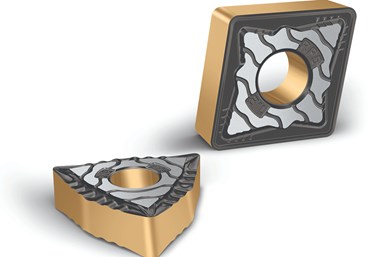Walter Tiger-tec Gold Inserts for Tough Steel Turning Applications
A highly textured MT-TiCN layer is said to reduce flank face wear and increases toughness due to its multilayered elastic structure.

Walter Tiger·tec Gold inserts. Photo Credit: Walter
Walter’s Tiger·tec Gold inserts are specially designed for turning operations in all steel applications, including low carbon steels and various alloy steels. The company says a key feature of these inserts is a CVD coating layer that enables process reliability for improved performance and longer tool life.
The layer structure involves a highly textured MT-TiCN (titanium carbonitride) layer which is said to reduce flank face wear and increase toughness due to its multilayered elastic structure. A highly textured aluminum oxide (Al2O3) layer increases the product’s resistance to crater wear, while the gold-colored top layer helps improve wear detection, the company says.
The final multistage posttreatment of these inserts is designed to ensure a rake face with reduced friction for easy chip evacuation and a high level of substrate toughness for resistance to chipping and notching.
With this technology, Walter is introducing three new CVD grades. The WPP10G has the highest wear resistance for continuous cuts primarily in steels (ISO P10) and secondarily in cast irons (ISO K20). The WPP20G is the universal grade capable of handling a range of applications, including continuous cuts to moderately interrupted cuts in steels (ISO P20) and with secondary applications in cast irons (ISO K30). The WPP30G is the toughest grades for steels (ISO P30) and secondary applications in cast irons (ISO K20), respectively. The WPP30G is also well suited for heavy interruptions, castings with scale, older unstable machine setups or any other applications that require a tough grade.
The primary application of these inserts is steels with various tensile strengths that can be machined, where the inserts can significantly help reduce the cost per component.
Walter is offering Tiger·tec Gold indexable insert grades with its signature geometries starting with finishing (FP5), medium machining (MP3, MP5, MU5) and all the way to roughing (RP7, HU5) as well as some other niche geometries for troubleshooting purposes.
Related Content
-
Tool Path Improves Chip Management for Swiss-Type Lathes
This simple change to a Swiss-type turning machine’s tool path can dramatically improve its ability to manage chips.
-
Parting Off: The Case for Standardizing on Sawing
The value of rotary saw cutting for parting off operations could boil down to simple economics paired with process efficiency gains.
-
Producing Micro Screws for the Watch Industry
Cutting tools play a key role in machining tiny screws on Swiss-type lathes for this Switzerland-based watch manufacturer.











.png;maxWidth=300;quality=90)




